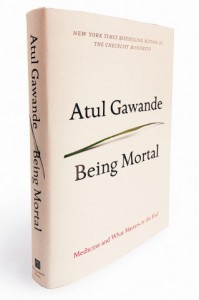 I recently read the book Being Mortal by Dr. Atul Gawande about empowering people to make end of life decisions. Now you might be wondering, what does that have to do with scrum? Well it turns out the same questions we might ask a dying person to help facilitate their end of life in an empowering way are the same ones we might ask a client to empower their scrum practice or agile transformation.
I recently read the book Being Mortal by Dr. Atul Gawande about empowering people to make end of life decisions. Now you might be wondering, what does that have to do with scrum? Well it turns out the same questions we might ask a dying person to help facilitate their end of life in an empowering way are the same ones we might ask a client to empower their scrum practice or agile transformation.
Dr. Gawande wrote the book about his experience (or lack of experience) having difficult yet essential end of life conversations with patients and their families. Conversations about what is important to the patient at the end of their life, what impact that might have on the treatments they undertake, and ultimately the experience they and their families might have.
Medicine has a natural tendency to promote life at any cost. As Dr. Gawande shows in the book, there is often a substantial cost to patients and their families as they are hoping that the next treatment will be “the one.”
While agile transformations are not end of life issues, there are some parallels for agile coaches here. We agilists often think the next coaching session or the next training or the next incremental improvement will be the game changer for our client. We are often driven by the power of the possibility we see for what agile practices can do for a company, or if you are like me, for the world.
In the book Dr. Gawande outlines two ways that doctors interact with patients: paternalistically or as an informer. In the paternalistic mode, the doctor treats the patient like a child and the doctor the good father, telling the patient what to do and reassuring them it will be ok. As the Informer, they are laying out all the objective options and information and assuming the patient will put it all together and make the best decision for their treatment. Often neither of these approaches empowers the patient and they are left at odds and unsupported in their decision about their treatment.
I could immediately see myself falling into both of these traps in my scrum training and coaching work. Sometimes, my client regards me as the expert and is eager to follow whatever advice I give. It’s all too easy to become the wise ‘parent’ in this scenario. Sometimes, I provide them with information about best practices and such and assume that they will make a good decision now that they are informed.
Going back to Being Mortal, Dr Gawande describes a third approach he learned from a hospice director: the interpretive approach. In this approach, the doctor starts by asking the patient: what they want the outcome to be, what’s important to them and what are they willing to do to get the outcome. Then they listen, a lot. They talk about tradeoffs in treatment and experience. They give options. They counsel. They listen to both the spoken and unspoken desires of their patients to understand what is truly important to them. In essence they are working with the patient and their family to create context, and then help them interpret the information so they can have the kind of treatment or end of life that really works for them. This is distinct from a longer life at all costs approach.
It strikes me that this approach could make a huge difference for our clients. First we help our clients think about and articulate what they really want (why they want to be more agile) and what they are willing to do to get it. From there, we can help them understand the possibilities of an agile approach and what that really means for them. This includes understanding the tradeoffs and the various options they might pursue. In this way, perhaps we could impact our clients by facilitating difficult conversations where they confront the reality of their culture and what they are willing to do or not do to have a result. From there the actions for them to take might be more clear and the motivation to take them much stronger.
For me, this means giving up my own attachment to the idea that agile practices are always the best thing, in every situation. This is like a doctor giving up the idea that prolonging life is always appropriate.
For now – I’m working on slowing down and asking my clients and students: “What do you want the outcome to be? What is your motivation for adopting scrum? And what are you willing to do to get it?” Then listening, without judgment or attachment, for how I can support them achieving their goal or outcome.

Agile folks may also know Dr. Gawande because of his book The Ckecklist Manifesto: How to get things right. It’s certainly related to our beloved concept of the definition of done. 🙂
Thanks Chris – I just read another “Agile” article by Dr. Gawande,
The Heroism of Incremental Care. A fascinating article on the impact of small incremental treatment changes for chronic illness improvement.
https://www.newyorker.com/magazine/2017/01/23/the-heroism-of-incremental-care